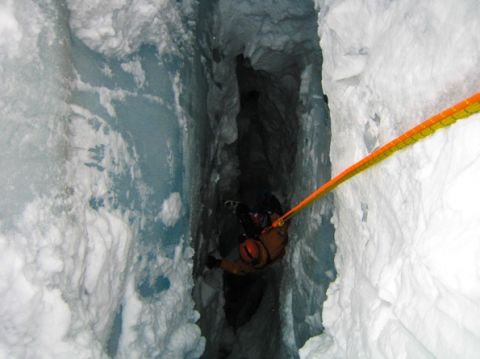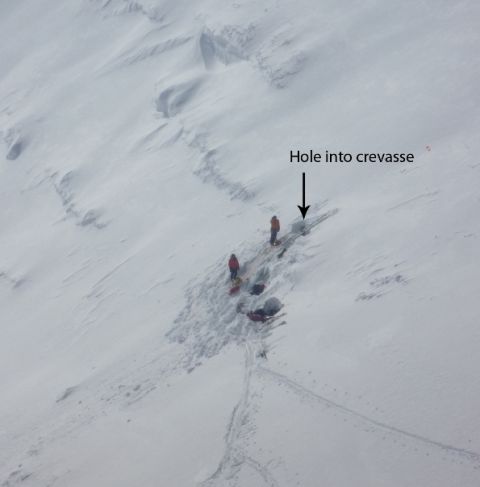Crevasse Danger increasing but should always be of concern - March 12th Wapta Traverse death
It has been a few months now since the death of a skier on the Wapta Traverse and I thought is was important to look at the Accident Report from Parks Canada given that this recent heat wave will soon be re-opening crevasses. Glacier travel is always a risky game that requires a different set of skills that most backcountry skiers don't typically poses. For the most part, in the interior of BC crevasses get covered over by up to 3 meters of snow each winter and then they rear their ugly head again in the late spring when winter's snow has melted away. The incident on the Wapta Traverse this March however shows the ever present danger of crevasse falls when backcountry skiing.
Have a read over the Parks Canada report below which includes several good pictures and keep this in mind as the spring ski touring season gets into full swing.
Let us know your thought about this incident either on the forums here or on our Facbook page over here.
Here is the Parks Canada report:
Un-roped crevasse fall, Daly glacier, Wapta Icefields, Yoho National Park, March 12, 2013
A party of three ski tourers were travelling over a number of days from Peyto Lake to Sherbrooke Lake on the popular Wapta traverse. They were using the Alpine Club of Canada hut system along the way. They left Balfour hut around 11:00AM on the morning of Tuesday March 12th, and crossed over the Balfour high col (approx. 3000m) in the early evening in near white-out conditions. The party un-roped at some point after starting to descend the Daly glacier and were skiing down towards the Scott Duncan hut which was 5km away. At approximately 7:30 PM, one member of the party fell into a crevasse. Another member of the party went to the edge on belay with a rope, and yelled into the crevasse with no response. They also received a weak beacon signal showing a beacon at 35M down into the crevasse. A rope was then dangled down 60m but there was no pull on the end. The party on the surface decided there was nothing the two of them could do given the darkness and weather, so they left their skis to mark the crevasse and walked up to a flat area above the crevasse and dug a snow cave. Their location was at approximately 2700m on the Daly glacier between the Balfour high col and the Scott Duncan hut. They activated the SOS on their SPOT satellite beacon at approximately 11:30 PM on March 12th.


From March 13th-15th, Visitor Safety (VS) rescue crews from Banff and Lake Louise flying with Alpine helicopters tried repeatedly to reach the area, but were unable to reach the site due to unusually stormy weather. Crews were also unable to access the site by ski-touring as the avalanche hazard at all elevations was rated high and conditions were too touchy given the visibility and terrain.
On March 15th, with the weather marginally better, a VS team was inserted near the crevasse by helicopter and they were able to ski tour up to the accident site. A pair of skis was spotted near the SPOT GPS location. The team investigated the skis and found an open hole in the crevasse. One VS rescue member looked into the crevasse and could see down with no visual clues. An avalanche beacon search did not reveal any signals and there was no response to shouts. As the helicopter was preparing to bring in more equipment for an extensive crevasse rescue, the pilot spotted a party of two on the surface who were a few hundred feet above the VS team. Immediately, the VS team’s priorities shifted to the two survivors, and the team skied up to them and escorted them to the nearby helipad. The survivors were evacuated by helicopter in very bad weather and taken to a hospital where they were treated for minor cold injuries. The weather and avalanche conditions were very poor for the next 4 days, until a clearing on Tuesday March 19th, when crews were finally able to access the crevasse site and reach the deceased.

Analysis
This incident occurred on a popular ski touring route that is often undertaken at that time of year. One causal factor for the incident was the party deciding to take off the rope in near whiteout conditions and fading daylight. It is not uncommon for parties to ski downhill un-roped on glaciers but parties should be aware of changing or unfamiliar conditions, snow depths, visibility, etc. when considering this. Another factor was that the party followed a route to the Scott Duncan hut which was different than the route most parties take, and ended up in steeper, crevassed terrain. Given their experience level, darkness, and the stormy conditions, the party thought it would be too dangerous to venture down the crevasse or to continue their way to Scott Duncan hut. This decision was the right one given their circumstance. In these situations, it may be possible to descend the hole to check on the fallen person, but actually getting someone out of a tight crevasse is a very difficult and technical process. It typically requires more rescue resources than parties have available to them.
The party left on the surface were prepared to bivy for numerous days with sleeping bags, a stove and fuel, food, extra clothing, and navigation equipment. They also had a SPOT satellite device which was accurate and enabled them to initiate a rescue. Of note, SPOT devices are only one way communication, so although Visitor Safety knew there was a call for help, they did not know the nature of the incident. There are many different types of devices on the market, from satellite phones to two way satellite messaging devices. If you purchase one, know who to call and how your particular unit works.








